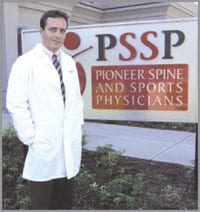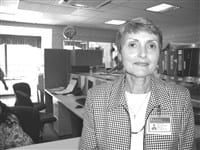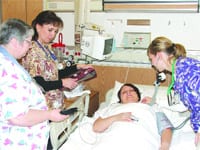Easing Their Pain Pioneer Spine and Sports Physicians Takes Comprehensive Approach
When someone suffers an injury to their spine, neck, or other skeletal-muscular structure, patience comes in handy.
Specifically, it can take months and multiple appointments to discover exactly what is wrong, and then get appropriate treatment to free the patient from pain and allow them to return to their normal activities.
“In the past, if someone had a herniated disk or a pinched nerve in their back or neck, their doctor may have referred them to a spine surgeon,” said Dr. Scott Cooper, managing partner at Pioneer Spine and Sports Physicians.
“If they didn’t need surgery, they may have been sent to physical therapy, then back to the surgeon, who may have ordered tests for the patient somewhere else. Then they may have returned back to the surgeon, been sent to a pain clinic to get injections, then had to go back to the surgeon again.”
The process can be slow and frustrating. And if something goes awry in physical therapy, or the therapist has a question for the physician, the patient typically has to wait until their next visit to have it resolved, Cooper said.
That’s one of the things that sets Pioneer apart from other treatment facilities. Since it employs doctors on site, if there is a question, a therapist can get immediate feedback, since all services are under one roof.
In addition, the staff knows which interventions work well and which ones have real limitations, Cooper said. “So we try very hard to order procedures and tests only when we know they will be helpful. By being more efficient, we can reduce treatment times and the time it takes people to recover.”
Pioneer Spine and Sports Physicians employs 13 doctors as well as physician’s assistants and physical therapists. They diagnose and treat many local high-school sports teams, and provide medical care to the Springfield Falcons, Western Mass Pioneers, and athletes at UMass Amherst, Western New England University and American International College in Springfield, Smith College in Northampton and a host of other schools. In addition, they work exclusively with large companies such as Callaway in Chicopee, MassMutual in Springfield and Enfield, and Hasbro and Lenox/American Saw in East Longmeadow, treating work-related injuries.
“We run a pediatric clinic at the Shriner’s Hospital and treat children as well as senior citizens,” Cooper said. “We are also are the medical directors of the acute rehabilitation units at Mercy’s Weldon Center and Noble Hospital’s Bronson unit. Our practice is very exciting because we treat so many different individuals and types of injuries. We have made it our goal to provide relief by using all of our skills in one setting with quality care that is cost-effective.”
Comprehensive Offerings
The flagship office on Park Street in West Springfield is housed in a 15,000-square-foot building which contains corporate offices as well as state-of-the-art equipment, a children’s alcove which kids can enjoy while their parents wait for an appointment, and a waiting room equipped with a small bank of computers so people can utilize their time effectively.
“We know that there will be times when people have to wait, so we want to make it a more enjoyable experience,” Cooper said, adding they see hundreds of patients each day.
The facility, which has been in business for more than 25 years, is overseen by Cooper and Dr. Ron Paasch.
Since they treat many work-related injuries, they also built a 5,500-square-foot Return to Work Center in East Longmeadow. “We can simulate almost any blue-collar job in a manufacturing setting at this site,” said Chief of Operations Geoff Elia. This allows patients to make sure they are ready and able to return to their job without aggravating any healing that has occurred after an injury or accident. Elia says patients come from as far away as Boston, and the center even boasts a conveyer belt and a simulated truck-loading dock.
In addition, Pioneer Spine and Sports offers athletic trainers who work in high schools alongside the schools’ trainers during games and practices.
Although it treats injuries when they occur, Cooper said, the center’s efforts are focused on prevention. To help accomplish this, it employs a six-week training program called Sportsmetrics, which focuses on developing overall leg strength and balance.
“We have had a tremendous response to this program. We established it three years ago because of the increasing prevalence of knee injuries, particularily in young females,” Cooper said. “Our goal is to maximize each individual’s ability to perform physically, whether this involves the workplace, home, or athletic field. We believe that continuity of care from the time of injury until the end of the rehabilitation phase is essential to meeting our goal.”
Their doctors diagnose and treat injuries in eight offices in West Springfield, Northampton, Greenfield, East Longmeadow, Springfield, Brattleboro, Vt., and Wallingford, Conn., where the business operates under the name Connecticut Spine and Sports Physicians.
On-site treatments include injections for a variety of conditions, and most offices have injection suites. “We have a C-Arm fluoroscopy machine which allows us to pinpoint the exact site where an injection is needed,” Cooper said.
In addition, they conduct on-site EMGs, or electromyogram testing, which involves testing nerves and muscles to determine if there is a problem.
The West Springfield office houses a large gym which is used for physical therapy. The therapists there see one patient at time, which Cooper said is uncommon in today’s world due to insurance reimbursement. A typical session lasts 45 minutes to an hour.
“We don’t put people on hot packs and walk away. What sets us apart is our manual hands-on therapy,” he said. This differs from modalities done using machines, which include electrical stimulation or ultrasound treatments.
“Hands-on osteopathic manipulation can be very helpful in improving mechanics and reducing pain,” he explained. “And if a patient is not responding as expected, the therapist can walk down the hall, talk to the doctor, and make modifications right then and there.”
Team Approach
Treating one condition with several physicians and at facilities which are not in close proximity to each other can be a lengthy process, since each practitioner establishes their own treatment plan.
“We have always felt that a person has a spine or sports related condition, it’s best to have the treatment coordinated in one place, whether it requires exercise, high-quality physical therapy, medications, or minimally invasive procedures such as nerve blocks and guided procedures,” Cooper said.
The center’s doctors treat everything from sprains and strains to athletic injuries, pinched nerves, disc injuries, spinal stenosis (which is degenerative and can cause a type of pinched nerve) whiplash injuries, and chronic pain. “We don’t emphasize medical management of pain, although we do have patients who need it. But for us, it’s a last resort,” Cooper said. “We can help patients heal who have suffered from chronic pain for a long time. Sometimes, their symptoms have been treated without a clear diagnosis of what is causing them.”
He explained that they do their best to determine where the pain is coming from before designing a comprehensive treatment program. “Sometimes, we see patients who have had some treatment. But often, other options have not been explored. And during physical therapy, we sometimes notice things which have not been previously appreciated.”
Although the therapists work closely with local surgeons and doctors, they try not to repeat tests. “That is more and more important as the health care environment changes,” he said. “It is not cost-effective, and our society is demanding that physicians and other providers provide high-quality care while being cost-effective. So we use a team approach.”
Cooper told HCN that it’s very satisfying to help people feel better. “We use our knowledge and do everything we can to provide people with relief, whether we are treating an elderly individual with an arthritic condition or a young athlete,” he said. “We want to emphasize their potential and optimize their functional capacity.”
And they accomplish that in a way takes the patient’s history and present condition into consideration — again,so they can return to their work and their lives as quickly as possible.




Comments are closed.